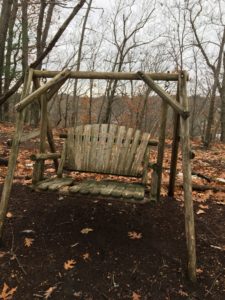A Description of the Landscape in the Style of Leopold

Dense clouds crowd together above my head, blocking the sun’s nourishing light. I step from the pavement into the arms of nature, taking in the wildlife around me. My feet squish into the wet soil saturated from the previous night’s rainfall. Puddles form mini pools. Fallen red and orange and yellow leaves swim across the puddles, slowly accumulating at the bottom. A mushy pile of leaves getting ready to return to the Earth. I move towards the water and admire the serenity of the ducks. Seeming to float on the surface, their beauty inspires awe deep within me. They drift unhurriedly with their webbed feet pushing them along like little hidden propellers overshadowed by a plump dark body covered in feathers. When I turn my head, among the natural grace of the tall, flowing grasses and the magnificent mighty trees, sits a handmade wooden swing for two. Although the seat is empty, the sentiment of the reciprocal relationship between beings and their landscape warms the air. I wonder who built the swing and placed it here and how many neighbors have sat upon it taking in the exquisite complexity of their surroundings. Here, all of Earth’s creations can come together in harmony and quiet appreciation of one another.
A Comparison of Weymouth and Burlington in the Style of Mary Holland
Seasons have begun to change. From the river shores of Great Esker Park in Weymouth, MA to the hidden alcoves behind the Aiken Forestry Research Center off the bike path in Burlington, VT, leaves change color and float to the ground. In Weymouth, ducks enjoy the water’s surface before it freezes over.

Many of them find their way here on their journey away from the approaching winter and others spend the whole year amid the tall browning grasses, including the Mallard. The landscape is alive with Red Oak trees whose leaves scatter across the Earth’s floor. Their acorns, however, are nowhere to be found. The squirrels have already begun their preparations for winter. In Burlington, snow has already fallen, hiding the fallen leaves and dying grasses. The only visible birds are the crows flying together over the landscape. Squirrels scurry across the snowy surface and up into the trees. The Oak trees are bare, but the Paper Birch retain a few yellowing leaves. This landscape’s richness has dwindled for the beginning of the winter season. A slight difference in temperature has grand implications for the features of these landscapes. One enjoys its last moments of color and warmth while the other settles into the coldest season of the year.
Phenology Place at Home
https://www.google.com/maps/d/edit?hl=en&hl=en&mid=1pOAKsfGSfhLtdxrV0GhGeItmPEC_EWN4&ll=42.230028831586125%2C-70.92759102316177&z=18
